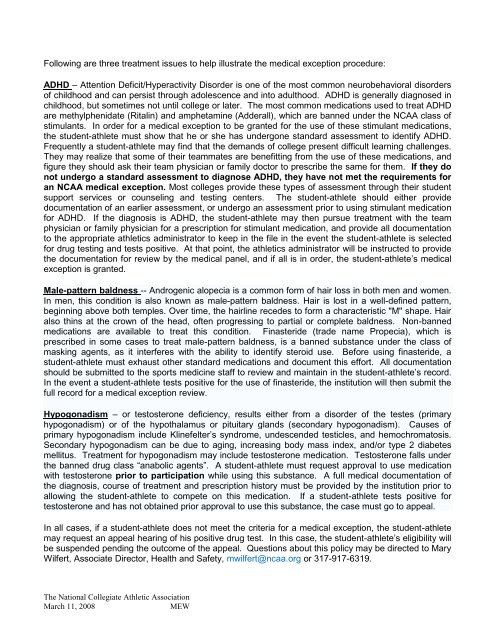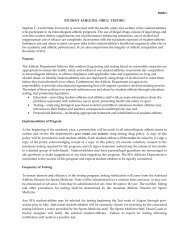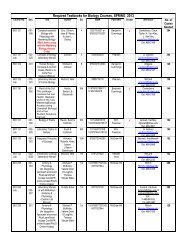NCAA Medical Exception Documentation Reporting Form to Support ...
NCAA Medical Exception Documentation Reporting Form to Support ...
NCAA Medical Exception Documentation Reporting Form to Support ...
- No tags were found...
You also want an ePaper? Increase the reach of your titles
YUMPU automatically turns print PDFs into web optimized ePapers that Google loves.
Following are three treatment issues <strong>to</strong> help illustrate the medical exception procedure:ADHD – Attention Deficit/Hyperactivity Disorder is one of the most common neurobehavioral disordersof childhood and can persist through adolescence and in<strong>to</strong> adulthood. ADHD is generally diagnosed inchildhood, but sometimes not until college or later. The most common medications used <strong>to</strong> treat ADHDare methylphenidate (Ritalin) and amphetamine (Adderall), which are banned under the <strong>NCAA</strong> class ofstimulants. In order for a medical exception <strong>to</strong> be granted for the use of these stimulant medications,the student-athlete must show that he or she has undergone standard assessment <strong>to</strong> identify ADHD.Frequently a student-athlete may find that the demands of college present difficult learning challenges.They may realize that some of their teammates are benefitting from the use of these medications, andfigure they should ask their team physician or family doc<strong>to</strong>r <strong>to</strong> prescribe the same for them. If they donot undergo a standard assessment <strong>to</strong> diagnose ADHD, they have not met the requirements foran <strong>NCAA</strong> medical exception. Most colleges provide these types of assessment through their studentsupport services or counseling and testing centers. The student-athlete should either providedocumentation of an earlier assessment, or undergo an assessment prior <strong>to</strong> using stimulant medicationfor ADHD. If the diagnosis is ADHD, the student-athlete may then pursue treatment with the teamphysician or family physician for a prescription for stimulant medication, and provide all documentation<strong>to</strong> the appropriate athletics administra<strong>to</strong>r <strong>to</strong> keep in the file in the event the student-athlete is selectedfor drug testing and tests positive. At that point, the athletics administra<strong>to</strong>r will be instructed <strong>to</strong> providethe documentation for review by the medical panel, and if all is in order, the student-athlete’s medicalexception is granted.Male-pattern baldness -- Androgenic alopecia is a common form of hair loss in both men and women.In men, this condition is also known as male-pattern baldness. Hair is lost in a well-defined pattern,beginning above both temples. Over time, the hairline recedes <strong>to</strong> form a characteristic "M" shape. Hairalso thins at the crown of the head, often progressing <strong>to</strong> partial or complete baldness. Non-bannedmedications are available <strong>to</strong> treat this condition. Finasteride (trade name Propecia), which isprescribed in some cases <strong>to</strong> treat male-pattern baldness, is a banned substance under the class ofmasking agents, as it interferes with the ability <strong>to</strong> identify steroid use. Before using finasteride, astudent-athlete must exhaust other standard medications and document this effort. All documentationshould be submitted <strong>to</strong> the sports medicine staff <strong>to</strong> review and maintain in the student-athlete’s record.In the event a student-athlete tests positive for the use of finasteride, the institution will then submit thefull record for a medical exception review.Hypogonadism – or tes<strong>to</strong>sterone deficiency, results either from a disorder of the testes (primaryhypogonadism) or of the hypothalamus or pituitary glands (secondary hypogonadism). Causes ofprimary hypogonadism include Klinefelter’s syndrome, undescended testicles, and hemochroma<strong>to</strong>sis.Secondary hypogonadism can be due <strong>to</strong> aging, increasing body mass index, and/or type 2 diabetesmellitus. Treatment for hypogonadism may include tes<strong>to</strong>sterone medication. Tes<strong>to</strong>sterone falls underthe banned drug class “anabolic agents”. A student-athlete must request approval <strong>to</strong> use medicationwith tes<strong>to</strong>sterone prior <strong>to</strong> participation while using this substance. A full medical documentation ofthe diagnosis, course of treatment and prescription his<strong>to</strong>ry must be provided by the institution prior <strong>to</strong>allowing the student-athlete <strong>to</strong> compete on this medication. If a student-athlete tests positive fortes<strong>to</strong>sterone and has not obtained prior approval <strong>to</strong> use this substance, the case must go <strong>to</strong> appeal.In all cases, if a student-athlete does not meet the criteria for a medical exception, the student-athletemay request an appeal hearing of his positive drug test. In this case, the student-athlete’s eligibility willbe suspended pending the outcome of the appeal. Questions about this policy may be directed <strong>to</strong> MaryWilfert, Associate Direc<strong>to</strong>r, Health and Safety, mwilfert@ncaa.org or 317-917-6319.The National Collegiate Athletic AssociationMarch 11, 2008MEW





